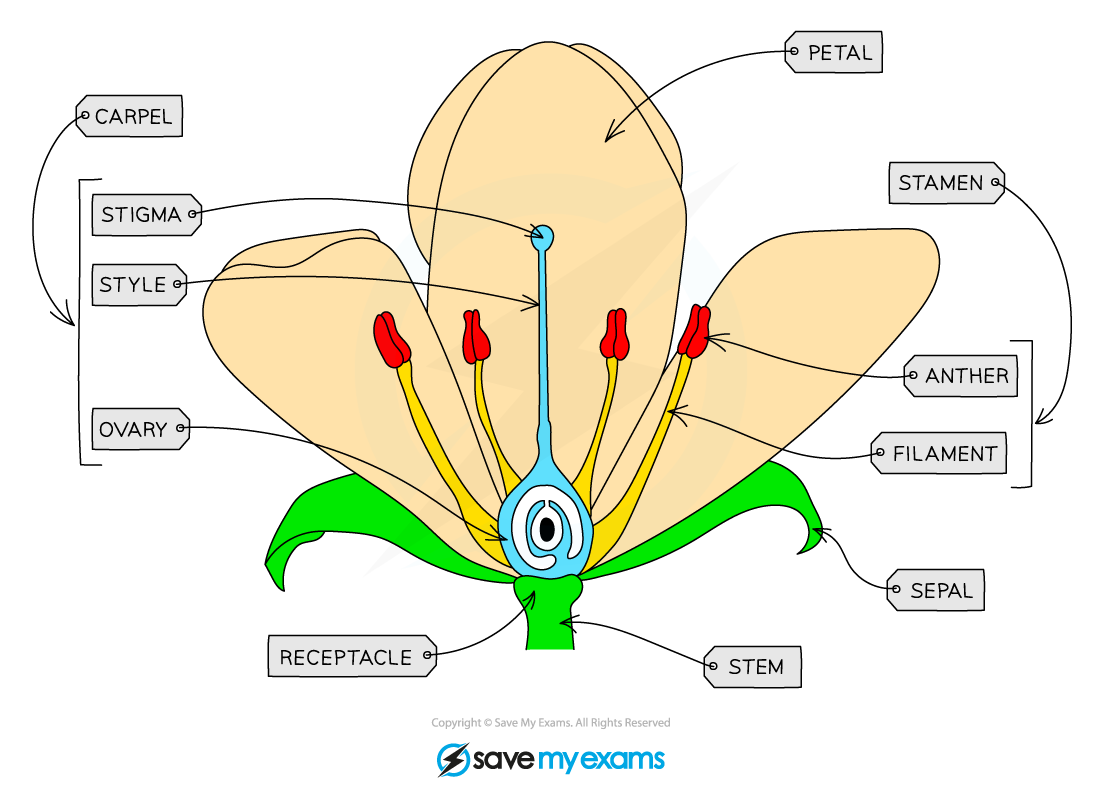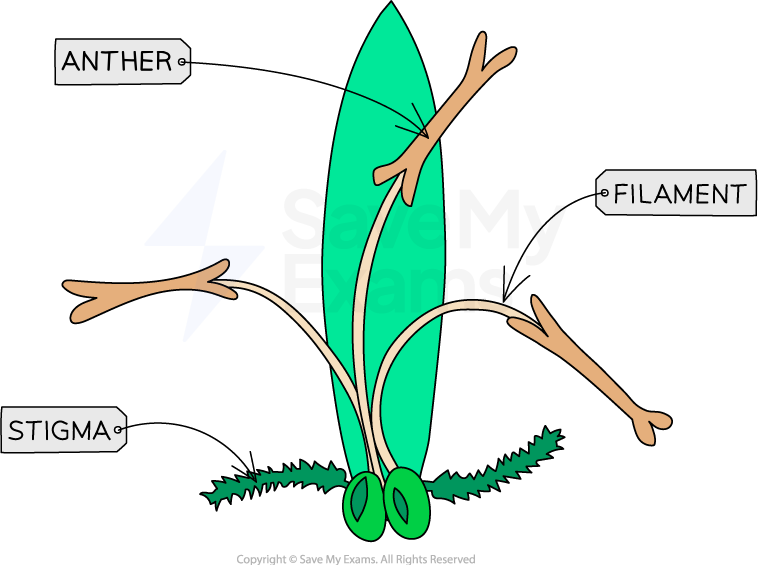Sexual Reproduction in Plants (Cambridge (CIE) IGCSE Co-ordinated Sciences (Double Award)) : Revision Note
Insect-Pollinated Flowers
Flowers are the reproductive organs of plants
They can contain both male and female reproductive parts
The male parts of flowers produce pollen grains; these contain a nucleus that functions as the male gamete
Unlike the male gamete in humans (sperm), pollen is not capable of locomotion (moving from one place to another)
The female parts of flowers contain ovules that contain the female gamete
During pollination pollen is transferred from the male to the female parts of the flower; this can occur due:
Insect pollination
Wind pollination
General flower structure diagram

Flowers are the reproductive organs of plants
Flower structures and functions table

Examiner Tips and Tricks
For the core syllabus, you need to be able to identify, draw and state the functions of the following parts of an insect-pollinated flower:
Sepals
Petals
Stamens
Filaments
Anthers
Carpels
Style
Stigma
Ovary
Ovules
Wind-Pollinated Flowers: Extended
Extended Tier Only
The anthers and stigma of wind-pollinated flowers are arranged differently to those in an insect-pollinated flower
The anthers hang outside the flower on long filaments so that wind can catch the pollen
The stigmas extend outside the flower and are often feathery to allow them to catch wind-borne pollen easily

Examiner Tips and Tricks
Students studying the extended syllabus need to be able to identify and describe the anthers and stigmas of wind-pollinated flowers.
Note that students studying the core syllabus do still need to be able to describe the structural adaptations of wind-pollinated flowers; this is covered in the core content below.
Pollination & Fertilisation
Pollination and fertilisation
Pollination can be defined as:
The transfer of pollen grains from an anther to a stigma
Fertilisation occurs after pollination when a pollen nucleus fuses with an ovule nucleus
The process of fertilisation in flowers involves:
The pollen grows a pollen tube down the style
The nucleus inside the pollen grain moves down the tube towards the ovule
After fertilisation a zygote has been formed which will develop into a seed


Fertilisation in a flowering plant involves fusion of a pollen nucleus with a nucleus inside an ovule
Examiner Tips and Tricks
Students often get confused between pollination and fertilisation in plants; they are not the same thing!
Pollination is transfer of pollen grains from anther to stigma
Fertilisation, as in animals, is the fusion of gametes
Adaptations of flowers
The features of insect and wind pollination flowers means that they are adapted to be pollinated by different mechanisms:
Adaptations of insect-pollinated flowers table

Adaptations of wind-pollinated flowers table

Worked Example

The answer is:
B; [1 mark]
The pollen grains in image 1 are large and have spikes on their surface which will allow them to attach themselves to an insect so they can be transported to another flower/plant.
The pollen grains in 2 and 3 are smaller and will be able to catch the wind easily for wind-pollination.
Did this video help you?
Factors Affecting Germination of Seeds
Germination is the start of growth in the seed
Three factors are required for successful germination:
Water - allows the seed to swell up and the enzymes in the embryo to start working so that growth can occur
Oxygen - so that energy can be released for germination
Temperature - germination improves as temperature rises (up to a maximum) as the reactions which take place are controlled by enzymes
As carbon dioxide is not necessary for germination but also does not inhibit it, it makes no difference whether it is present or not
Investigating Germination
Set up 4 boiling tubes each containing 10 cress seeds on cotton wool
Set each test tube as shown in diagram below
Leave tubes in the set environment for a period of time:
A, B (control) and C incubated at 20°C;
D placed in a fridge at 4°C
Compare results and see which tube has the greatest number of germinated seeds

Conditions required for germination
Conditions required for germination - results:


You've read 0 of your 5 free revision notes this week
Sign up now. It’s free!
Did this page help you?
